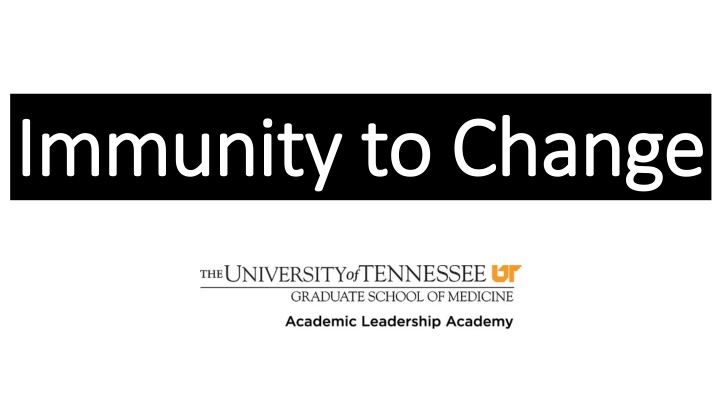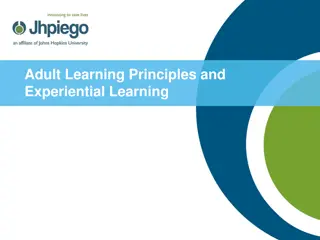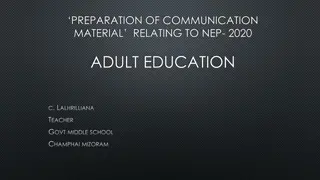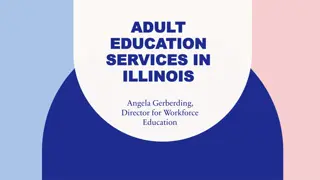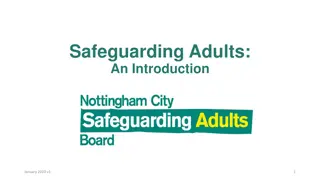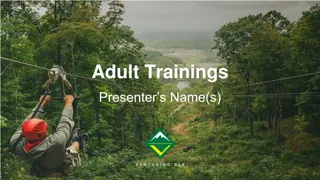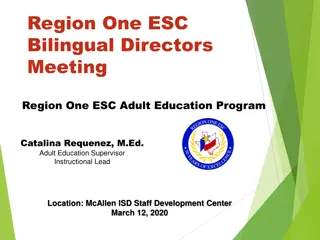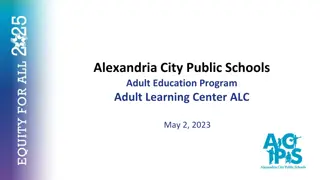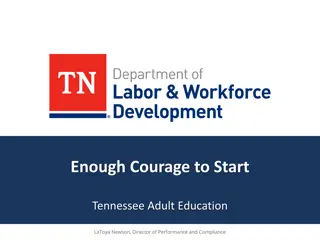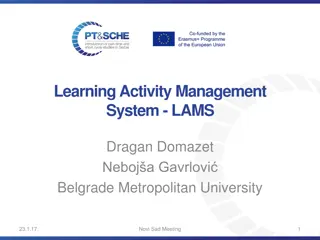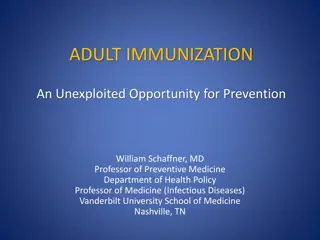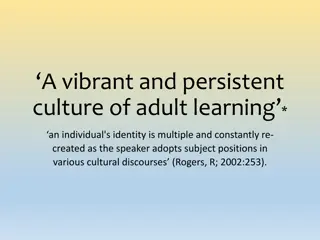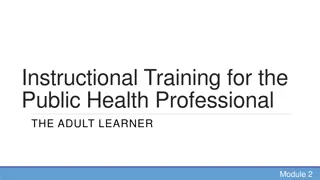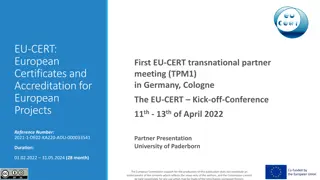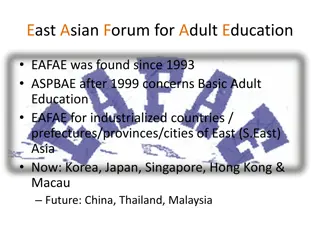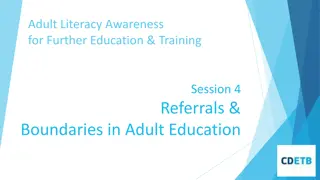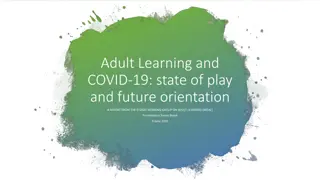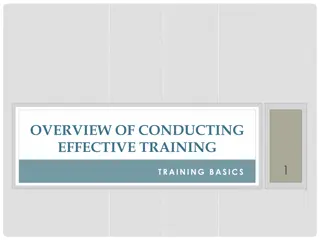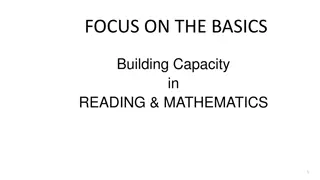Adult Learning and Development
Explore the concept of adult learning and personal development through informal and formal contexts. Dive into the significance of meaning-making and experiential learning in shaping our existence. Understand the evolving complexity of meaning-making systems in the journey of adult development.
Download Presentation

Please find below an Image/Link to download the presentation.
The content on the website is provided AS IS for your information and personal use only. It may not be sold, licensed, or shared on other websites without obtaining consent from the author.If you encounter any issues during the download, it is possible that the publisher has removed the file from their server.
You are allowed to download the files provided on this website for personal or commercial use, subject to the condition that they are used lawfully. All files are the property of their respective owners.
The content on the website is provided AS IS for your information and personal use only. It may not be sold, licensed, or shared on other websites without obtaining consent from the author.
E N D
Presentation Transcript
Immunity to Change Immunity to Change
and Professional Development Harvard Graduate School of Education Co-director of Harvard-Macy Institute for the Reform of Medical Education (HGSE and HMS) Co-director of the Change Leadership Group William and Miriam Meehan Professor of Adult Learning Robert Kegan, PhD
Adult learning Adult learning Learning is an element of human personal and professional development that occurs in a variety of informal and formal contexts. Informal learning Meaning making Formal learning Adult learning Lifelong learning
Informal learning Informal learning Ourmeaning making equates to informal learning that develops through an interpretive lens by which we construct the meaning of our experiences. We don t see things the way they are, we see things the way we are. Anais Nin
Informal learning Informal learning Meaning making occurs when we construct the meaning of events and experiences that are a part of and shape our existence in that thinking and reflecting is all that is required to accomplish this type of learning. Experiential learning = constructive development
Many adults live out their entire lives constructing reality according to a mental system not significantly more complex than the one they evolved in adolescence.
Three increasingly complex meaning-making systems Socializing mind Self-authoring mind Self-transforming mind
Socializing mind Socializing mind 3 3rd rd order of consciousness order of consciousness Motivated externally. Shaped by the definitions and expectations of one s interpersonal environment. The self coheres by its alignment with/loyalty to that with which it has uncritically become identified. Primarily expresses itself in relationships with people, or ideas and beliefs, or both.
Self Self- -authoring mind authoring mind 4th order of consciousness 4th order of consciousness Motivated internally. Able to step back sufficiently from the social environment to generate an internal seat of judgement or personal authority that evaluates and makes choices about external expectations. The self coheres by its alignment with its own belief system/ideology/personal code by its ability to self-direct, take stands, set limits, create and regulate its boundaries on behalf of its own voice.
Self Self- -transforming mind transforming mind 5th order of consciousness 5th order of consciousness Shaped by the ability to step back and reflect on the limits of one s own ideology or personal authority with the knowledge that any one system or self-organization is in some way partial or incomplete. Looks favorably toward contradiction and oppositeness, seeking to hold onto multiple systems rather than projecting all but one onto the other. The self coheres by its ability to distinguish internal consistency from wholeness or completeness, aligning with the dialectic rather than either pole.
Complexity level % 3rd order 3% Between 3rd and 4th order 36% 4th order 44% Between 4th and 5th order 15% 5th order 2% Bushe GR, Gibbs BW: Predicting organization development consulting competence from the Myers-Briggs type indicator and stage of ego development. J Applied Behavioral Science 26: 337-357, 1990.
The The c coachee s expectations of the coach oachee s expectations of the coach 5th order coachee 4th order coachee 3rd order coachee Looks to the coach to: Support my efforts to develop my opposite or externalized sides. A special collaborator. A partner to my development. Looks to the coach to be: A respectful perceiver of my way. A special resource. A partner to my effectiveness. Looks to the coach to be: A worthy source of authority and expertise that will provide direction. A special guide. A partner to create my purpose.
Views of success Views of success 5th order of consciousness 4th order of consciousness 3rd order of consciousness were formally seen as opposite or externalized. I am more open to different metrics in evaluating quality, intelligence, effectiveness recognizing that for all the strengths of any metric, it is inevitably partial. I seek connection with less developed sides of myself that I am responsible for working out my own definition of success. Success is satisfying my standards and definition of success. I am responsible for my success according to the organization s standards. Success is satisfying the organization s standards. Looking outside myself for direction.
Immunity to Change (ITC) Immunity to Change (ITC) Assists individuals in addressing adaptive challenges with adaptive means. The overarching concept of constructive developmental adult learning is that we increase our mental complexity, enabling ourselves to see more deeply into ourselves and our world. We develop through our gradual and successive ability to step back and look at the lenses we were formerly looking through. We create a subject to object shift.
Subject Subject- -object theory of adult learning object theory of adult learning SUBJECT OBJECT That which we unquestionably assume to be true, something with which we are fused, and therefore something we are unable to reflect or question. Something that is separate or distinct from oneself, and something that we can organize and potentially change.
Immunity to Change (ITC) Immunity to Change (ITC) The Immunity to Change approach reinforces a mind-shift in one s way of thinking by helping individuals move aspects of their thinking and feeling from a place where they are subject to them (they run that individual) to a place where they become object for them (they can make choices about them).
The amygdala Under normal circumstances, sensory stimuli move from the thalamus to the neocortex. that emotion with what it already has on the danger list. The brain has emotion before reason is activated. The rational area of our brain cannot stop the emotion detected by our limbic system. Amygdala is activated when emotionally stressed. Simultaneously, the hippocampus compares Cerebral cortex Basal ganglia Thalamus Hippocampus Immunity to Change requires involvement of the neocortex and the amygdala Neocortex is the seat of judgement of the brain. The place where we analyze and reflect. Can be over-ridden by the amygdala during fight response.
3. Competing/hidden Commitments 4. Big Assumptions 1. Improvement Goal 2. Doing/not doing What is the optimal area for you to improve in order to be an even more effective ________? Turn this into a goal Statement. Imagine doing the opposite of your column 2 behaviors. What fears come up for you? WORRY BOX Then, drawing on the idea that you may have a commitment to keep that fear from happening, turn your fear into a commitment statement. What are you currently doing and not doing that gets in the way of your column 1 commitment? What assumptions must you be making that make your column 3 make perfectly good sense? Or, complete an if, then : (opposite of column 3), then ______? IMMUNITY TO CHANGE MAP Column criteria Makes column 3 goal absolutely necessary. Has a big time bad conclusion for you. Displays a contracted world Feels powerful (4 or 5). Column criteria It s true for you. Implicates you. It s stated affirmatively. There s room for improvement. It s important to you (4 or 5). Involve an adaptive challenge. Require a mindset change. Column criteria Follows from fear. Commitment to self-protection. Shows why column 2 behaviors make good sense. Feels powerful, you can see the Immune System. Column criteria Behaviors (not inner states). These behaviors get in the way of or work against column 1 commitment.
3. Competing/hidden Commitment WORRY BOX 4. Big Assumptions 1. Improvement Goal 2. Doing/not doing I assume that if I am perceived as forcing change on my faculty, then they will intentionally not engage in this process and not favorably develop as better teachers. I am committed to becoming better at serving as an adaptive leader with collaboration in my academic department. I am not effectively mentoring faculty to become better teachers by insisting that they do things my way. I fear that education will not improve if I permit the faculty to do things their way. I fear that if I delegate responsibility to my faculty that they will not accomplish tasks in an acceptable time frame. I assume that if I delegate responsibility to my faculty then they will not accomplish their tasks in a timely fashion. I am not delegating sufficient responsibility to my faculty. I fear that if I encourage my faculty to be agents of educational change, their recommendations for change will be unacceptable to me. I am not permitting faculty in my department to serve as agents of favorable change. I assume that if I encourage my faculty to be agents of change, their recommendations will be unacceptable to me. HIDDEN COMMITTMENTS I am not leading the department in a collaborative fashion. I am also committed to not being perceived as not permitting my faculty to afford their own changes. I assume that if I fail in this exercise, then my Dean will look unfavorably upon my leadership skills. Adaptive leader Empowers people to do the work while remaining engaged in the process. I am also committed to not sending the message that the delegation of responsibility will not be able to be accomplished in a timely fashion. I am also committed to not sending the message that the recommendations for change will not be acceptable to me.
